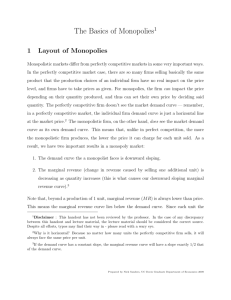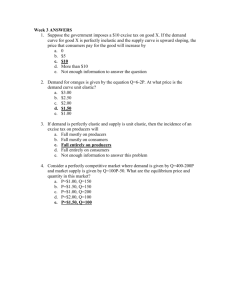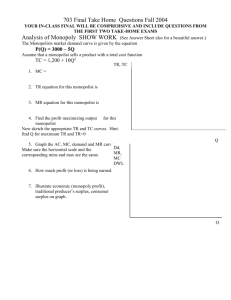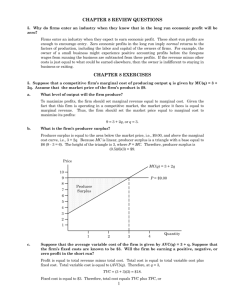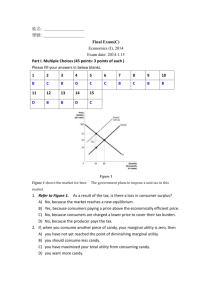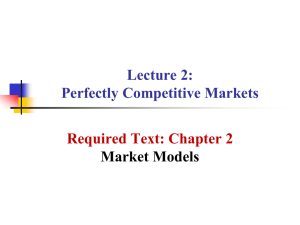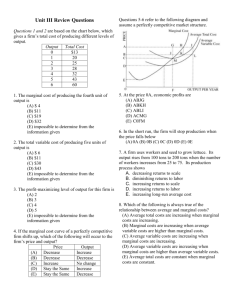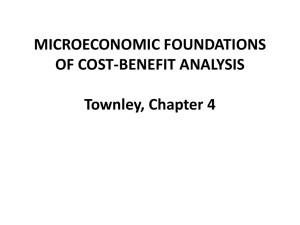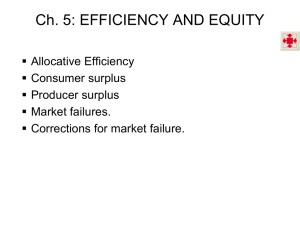Take up Midterm 2 Solution
advertisement
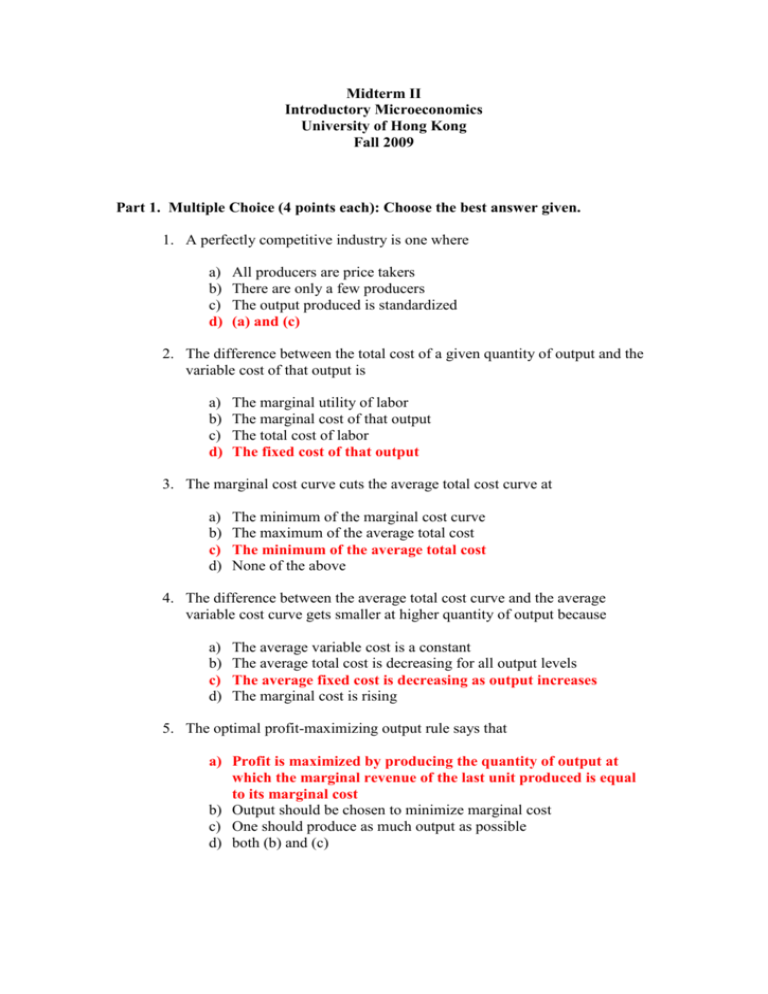
Midterm II
Introductory Microeconomics
University of Hong Kong
Fall 2009
Part 1. Multiple Choice (4 points each): Choose the best answer given.
1. A perfectly competitive industry is one where
a)
b)
c)
d)
All producers are price takers
There are only a few producers
The output produced is standardized
(a) and (c)
2. The difference between the total cost of a given quantity of output and the
variable cost of that output is
a)
b)
c)
d)
The marginal utility of labor
The marginal cost of that output
The total cost of labor
The fixed cost of that output
3. The marginal cost curve cuts the average total cost curve at
a)
b)
c)
d)
The minimum of the marginal cost curve
The maximum of the average total cost
The minimum of the average total cost
None of the above
4. The difference between the average total cost curve and the average
variable cost curve gets smaller at higher quantity of output because
a)
b)
c)
d)
The average variable cost is a constant
The average total cost is decreasing for all output levels
The average fixed cost is decreasing as output increases
The marginal cost is rising
5. The optimal profit-maximizing output rule says that
a) Profit is maximized by producing the quantity of output at
which the marginal revenue of the last unit produced is equal
to its marginal cost
b) Output should be chosen to minimize marginal cost
c) One should produce as much output as possible
d) both (b) and (c)
6. The short run supply curve for a perfectly competitive firm is
a)
b)
c)
d)
The upward sloping portion of the average variable cost
The upward sloping portion of the average total cost
The upward-sloping marginal cost curve
The horizontal marginal cost curve
7. In general, a monopolist
a)
b)
c)
d)
Produces more output than a perfectly competitive firm
Sets a higher price than a perfectly competitive firm
Incurs deadweight loss since he/she restricts production
(b) and (c)
8. In some industries, monopolists persist because:
a)
b)
c)
d)
There are barriers to entry
There are significant economies of scale
The government grants exclusive right to only one firm
All of the above
9. A perfectly discriminating monopolist:
a)
b)
c)
d)
reduces economic efficiency compared to a regular monopolist
creates deadweight loss
charge the same high price to all individual consumers
none of the above
10. In the short run, a monopolist can theoretically:
a)
b)
c)
d)
make economic profits
make economic losses
make zero economic profits
all of the above
Short Answer Questions
1. (12 points) Draw and label a graph showing a perfectly competitive firm
making economic profits in the short run. What is the profit-maximizing
output? How big are the economic profits? Indicate and label in your graph.
What is the difference between economic profits and accounting profits?
Profit-maximizing output is at the point where P = MC, Q*.
Accounting profit = Total Revenue – Explicit cost
Economic profit = Total Revenue – Explicit cost – Implicit cost
The difference between Accounting profit and Economic profit equals to
Normal profit.
Normal Profit = Accounting Profit – Economic Profit
2. (12 points) Suppose a perfectly competitive firm is incurring economic
losses in the short run. Show this situation in a graph. Indicate how much
economic losses are in your graph. Should the firm shut down in the short run
in your graph?
Suppose now the firm is instead making zero economic profits, show in a
separate graph this new situation.
According to this graph, the firm is incurring a loss because P<ATC; and will
not shut down, P>min. AVC. The firm will shut down if any price level is less
than P*, P* < min. AVC.
According to this graph, P* = MC = ATC. The firm is earning zero economic
profit.
3. (12 points) Candidate Barack Obama and candidate Hilary Clinton can be
analyzed as duopolists. They have two strategies: to cooperate with each other
(smear candidate John McCain but not each other) or to fight each other
(smear each other). Suppose their payoff matrix is similar to one of prisoner
dilemma. Illustrate the Clinton-Obama game. Write down a hypothetical
payoff matrix. Which equilibrium will the two candidates choose? Why? Is
there a dominant strategy?
Clinton
Cooperate
Fight
Obama
Cooperate
15 voters each
Obama: 5 voters
Clinton: 20 voters
Fight
Obama: 20 voters
Clinton: 5 voters
10 voters each
Nash equilibrium is {Fight, Fight} at (10, 10). This is the best choice for Obama
and Clinton. They will have no incentive to deviate from this outcome.
Dominant strategy – is one that yields a higher payoff no matter what the other
players in a game choose.
Their Dominant strategy is to fight with each other.
This is a prisoner dilemma,” a game in which each player has a dominant
strategy, and when each plays it, the resulting payoffs are smaller than if each
had played a dominated strategy.”
It is because if they following their dominant strategy, both fight, they will only
get 10 voters. They could have got 15 voters if they both cooperate with each
other and smear John McCain.
4. (12 points) Suppose a natural monopolist is faced with a constant marginal cost
curve. Show graphically the natural monopolist maximizing his/her economic
profits. How does the monopoly output compared to the alternative hypothetical
perfectly competitive output? How does the monopoly price compared to the
perfectly competitive price? Indicate in your graph. Also show in your graph the
extent of deadweight loss.
The monopoly output, QM, is smaller than the perfectly competitive output, PP.
The monopoly price, PM, is larger than the perfectly competitive price, PP.
5.
(12 points) Define consumer surplus and producer surplus. Draw in a graph a
supply curve and a demand curve for home heating oil. In the graph, identify
and label the area for consumer surplus and the area for producer surplus.
Suppose an effective price ceiling is put onto this market, how would the
amount of consumer surplus be affected? Show in your graph. How would the
amount of producer surplus be affected? Show in your graph. How happen to
economic efficiency? Show in your graph.
Consumer surplus is the difference between a buyer’s reservation price and the
price actually paid.
Producer surplus is the difference between the price a seller actually received
and the seller’s reservation price.
After the price ceiling, producer surplus decreases; however, consumer surplus
may increase/decrease.
In general, after the price ceiling, it creates a deadweight loss and thus reduces
economic efficiency.
END
